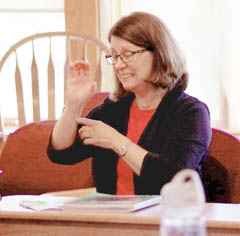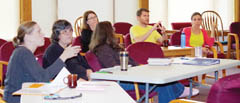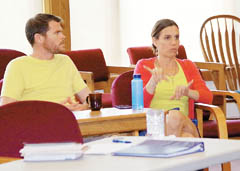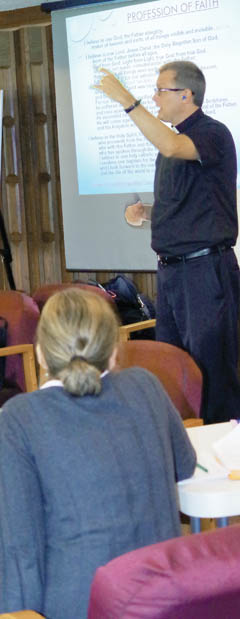



ROCKFORD—Hold up one index finger pointing upward to represent God the Father.
Hold up your other index finger to represent God the Son.
To show a theological concept like “begotten,” says Msgr. Glenn Nelson, if you put the Jesus finger directly behind the Father finger and then move them a few inches apart, it gives a better visual interpretation than if you simply place the two individual fingers next to each other before moving them apart.
Try that easy motion, and you’ll have a better sense of the purpose behind Religious ASL Week, held this year from July 12-17.
Msgr. Nelson, vicar general, moderator of the Curia, and director of the Deaf Apostolate in the Diocese of Rockford, now organizes the annual event, which was first offered for about 10 years in Michigan and, since 2010, at Bishop Lane Retreat Center.
ASL stands for American Sign Language. It has its own grammatical structure, Msgr. Nelson explains, saying that, “It’s not just a language, it’s a culture.”
Interpreting spoken and written language into ASL is not a matter of signing or spelling things word-for-word.
Like spoken languages, ASL is a living, growing language, and the liturgical experience “actually contributes to the growth of the language.”
The process for liturgy “makes the language of the Mass visible,” Msgr. Nelson adds.
Each year, people from around the country come to learn how to better interpret theological concepts within the Mass for their deaf parishion-ers. They are a mix of people — Catholic and non-Catholic certified interpreters, deaf and hearing lectors, lay ministers, priests, deacons and seminarians — all of whom already possess a working knowledge of American Sign Language.
Joan Macy of the Archdiocese of Kansas City in Kansas has attended three of the workshop retreats, though she wasn’t there this year.
A cradle-Catholic and graduate of Catholic schools and college, Macy calls the week “immensely helpful” to make her signing more true to Church teaching. After her first training, she asked the deaf parishioners she serves if they noticed a change in her signing.
“They said (the Mass) was so much more clear,” Macy says.
They also told her that her signing now was teaching them more about their Catholic faith.
She spread the word about the RASL week to fellow interpreters, and the following year five or six others from that archdiocese attended.
“It’s had a huge, positive impact in our diocese,” Macy says of the training.
The more than 20 participants this year came from places like San Diego, New Jersey, Green Bay and Atlanta, Msgr. Nelson says.
They were divided into two groups — those with intermediate ASL skills and those more advanced.
Learning interpretation
They spent the week gaining insights from Msgr. Nelson for interpreting what he calls the “frozen” texts of the Mass.
They also learned from two other teachers about interpreting the changing parts of the Mass, including the readings.
The training also gives the signers an “awareness of what deaf Catholics want and need from the music portions of the Mass,” according to the RASL brochure.
The entire week is held in silence — providing greater training in ASL overall and allowing the hearing participants to better immerse themselves in the deaf world.
Msgr. Nelson says he wears earplugs all week to help him better “enter into a world of true silence. ... That silence is a rich soil in which the fruits of the (ASL) language may grow.
“Every time I do (this class), I get new insights,” he says.
Msgr. Nelson is grateful for the Rockford deaf community whose members volunteer to transport participants who arrive on the bus and treat them to homemade and other goodies at the end of each intense training day.
He is hopeful that bishops around the country “will become aware of what we have to offer during RASL week,” he says.
“Some dioceses do not have a formal Deaf Apostolate office, or clergy who know how to sign Mass and hear confessions, or lay ministers who are adequately trained to communicate or translate within a religious context.”
Those who attend the RASL week, he adds, “oftentimes return home feeling more confident in being able to translate the English written texts into American Sign Language and so minister better to the needs of the deaf Catholic population within their home diocese.”














